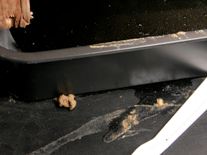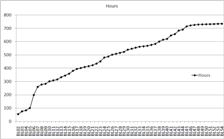
Figure 18: Iron and sulphur residues (orange material) exuding from the block.
The fundamental argument for block lifting is that it can aid in the discovery and recovery of very small and/or fragile artefacts and for their subsequent assessment and recording in situ relative to one another. This is possible because, like any laboratory-based work, block lifting attempts to remove obstacles and variables that are present during fieldwork, including the time pressure on excavation, the size and aggressiveness of the tools used to excavate, the elimination of bad weather and the ability to record immediately (minimising loss of data), and provides access to bright, consistent lighting as well as magnification. There are also disadvantages to block lifting which were recognised in the planning of this project. These include: the damage to material cut during the removal of the block, the removal of the material from the trench, which makes noticing spatial relationships between objects more difficult and, most significantly, the time and expense of carrying out the micro-excavation. As noted at the beginning of this article, other archaeologists who have used block lifting have faced similar issues. This section will summarise the major advantages and disadvantages of block lifting at Star Carr.
The excavation of the block has provided fine detail regarding the changes in peat build up and vegetation growth, through the examination of the plant macrofossils and sediment analysis. However, two column samples were excavated from the opposite trench section at the end of the excavation and also analysed, and these produced the same results (Hall 2009, 3). Therefore the excavation of the block was not necessary in order to obtain these data.
The most important information from the block has been the evidence of woodworking, in the form of wood chips with parallel sides. Although some had been identified during excavation, and MT visited the site several times to help in this regard, more have been found within the block. It is possible that the excavation of the block might produce more, or perhaps smaller, woodchips than the open excavation but the difficulty in quantifying the damage caused by the cutting of the block tends to outweigh this. Similarly, the excavation of the block might mean that woodchips can be excavated under more controlled conditions but this has to be balanced against the loss of detail caused if the slower pace increases the risk of deterioration. Detailed sampling in the field might produce more of the smaller material which could be used as a control.
The block excavation did not deliver the sorts of finds that had been hoped for, such as fish bones, twisted fibres, netting or thongs. However, it is perhaps not so surprising that such remains were not encountered, following work carried out in 2007 by AN (Needham 2007), which demonstrated that these deposits are extremely acidic, approximate pH 3.0, and further investigation as part of an English Heritage-funded project has demonstrated this across a larger area (Boreham 2009). The antler recovered from the 2007 trench was very flattened and in some cases severely degraded, unlike that found in the previous excavations (Elliott 2009). In addition, the 'jelly bone' appears to be bone that has demineralised and turned to gelatine. Unsurprisingly, the acidity of the sediments was in evidence during the excavation of the block in the laboratory. Once unwrapped, the smell of sulphur, rather similar to rotten eggs, was very strong and during excavation iron and sulphur residues exuded out of the block and into the tray below (Fig. 18). This constant oxidation of the deposit was problematic and potentially any small pieces of organic material that had survived may have been lost once exposed to the air.
Although excavating in the laboratory has been argued to be easier than excavating in the field, some similar difficulties are faced. The awkward physical access was a problem – it was often extremely uncomfortable excavating across the block for long periods of time. The lower levels of the block were often very difficult to excavate effectively due to the drop between the edge of the box and the top of the sediment. This was particularly difficult in the north-west corner. Excavating under artificial light for long periods could also be problematic owing to the limited spectrum provided by fluorescent lighting.
Several problems were experienced when trying to match the evidence from the trenches with the block. Most notably, the ends of the long pieces of wood found at the base of the trench, which potentially held the most information about their working, did not appear in the equivalent levels of the block and must have been severed, thus losing important information.
The cutting of the block also caused difficulties with individual pieces of debris. Of the seven pieces of parallel-sided debris, three had incomplete lengths. It is possible that these seven pieces of debris are, in fact, parts of much longer pieces which continued outside the block. Alternatively, they may originally have been only slightly longer but the ends have been damaged by the cutting. Either way, the problems of interpretation are increased by the inaccurate measurements this creates. Analysis of woodworking debris, like the analysis of flintworking debris, relies heavily on relative dimensions. The wood from Star Carr is so deteriorated and compressed that the thickness is likely to be distorted and the weight of the wood debris cannot be used because of variations in the moisture content. This leaves length and breadth as the remaining measurements. If nearly half of the lengths are truncated by the cutting of the block, then any kind of statistical analysis becomes impossible. Analysis and interpretation of such fragile material is fraught with difficulties and the damage done during the cutting of the block has added to these difficulties.
Perhaps the biggest issue is the resourcing of such an exercise. The block took the equivalent of nearly 20 working weeks to excavate (Fig. 19) and record to the standards set out in the previous block attempt (Mellars 1998, 69). It was carried out by PH, who at the time was an undergraduate from Bradford University on placement on the Star Carr project at the University of York. As noted for March Hill, projects like this usually end up relying on student labour and to carry out a larger-scale exercise that is properly costed will often be prohibitive.

© Internet Archaeology/Author(s) URL: http://intarch.ac.uk/journal/issue28/2/5.html
Last updated: Thu Mar 25 2010